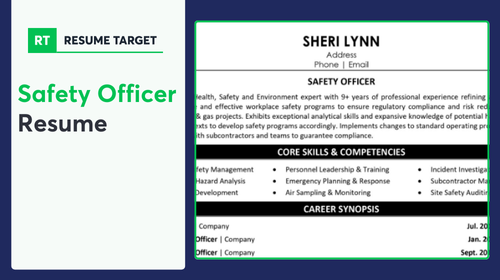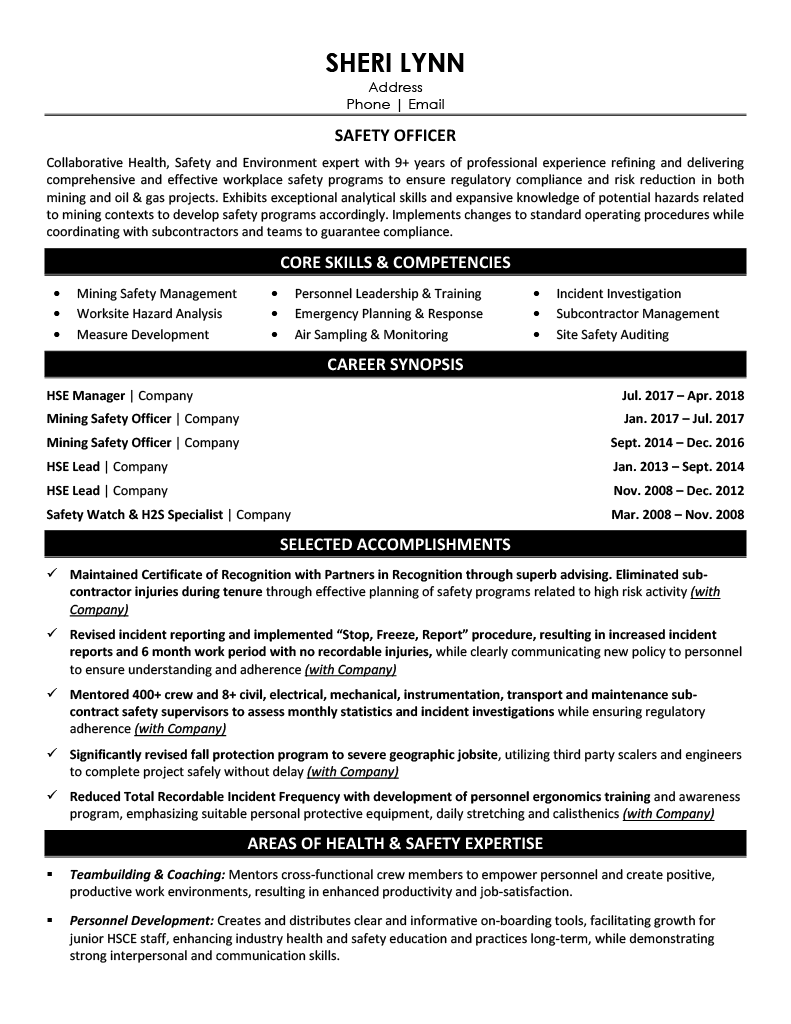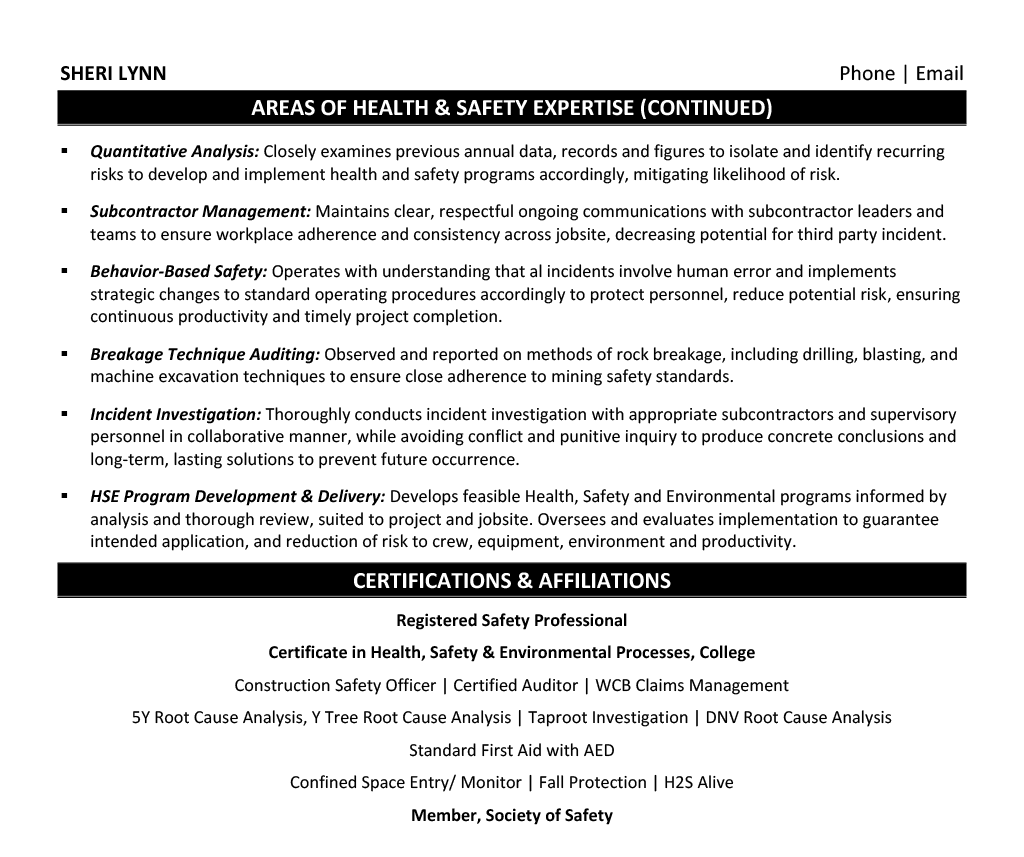

Safety professionals face a unique challenge: translating accident prevention and risk management into compelling resume content. Most safety officers struggle to quantify their impact when nothing going wrong is actually a sign of success.
Are you finding it difficult to showcase your value beyond compliance metrics? Your resume needs to demonstrate both your technical expertise and your ability to create a culture of safety that protects people and profits.
Resume Target specializes in helping safety professionals transform their daily responsibilities into powerful success stories. We'll show you how to highlight your risk management achievements and leadership skills in a way that catches hiring managers' attention.


In today's workplace, Safety Officers serve as the frontline defenders of employee wellbeing, conducting critical workplace inspections to identify and eliminate potential hazards before they can cause harm.
These vigilant professionals combine their expertise in safety regulations with practical problem-solving skills to develop comprehensive safety programs, lead employee training sessions, investigate incidents, and maintain detailed documentation that keeps organizations compliant and workers protected.
Whether you're drawn to the challenge of creating safer workplaces or passionate about protecting others, a career as a Safety Officer offers multiple paths for growth - from specializing in specific industries like construction or healthcare to advancing into senior safety management roles where you'll shape organization-wide safety culture.
Let's talk about what's exciting in the Safety Officer field! Your career path as a Safety Officer offers impressive earning potential that grows substantially with experience. And guess what? Your expertise in protecting workplace safety and managing risk prevention programs is increasingly valued across industries, leading to competitive compensation packages.
Figures from: OSHA Outreach Courses
Safety Officers can advance from entry-level positions to senior management roles with the right experience and certifications. Your career path could lead to becoming a Safety Director or even Chief Safety Officer.
To accelerate your career growth, you'll need to master both technical expertise and leadership capabilities that go beyond basic safety protocols.
- OSHA Certification and Compliance Knowledge - Risk Assessment and Safety Program Development - Emergency Response Planning - Leadership and Team ManagementBreaking into the safety officer field starts with combining education and hands-on experience, typically through a bachelor's degree in occupational safety or a related field plus entry-level safety work.
To advance in this field, you'll need to develop key competencies including communication skills, detail orientation, and problem-solving abilities through progressive experience.
Requirements from BCSP
From healthcare to construction, Safety Officer roles are thriving across the Northeast with competitive salaries and growth.
Figures from Zippia
Struggling to showcase your safety expertise, incident prevention track record, and leadership abilities in a way that truly captures your impact as a Safety Officer? This comprehensive, section-by-section guide will walk you through exactly how to build a powerful safety professional resume that highlights your achievements and demonstrates your value to employers.
As a Safety Officer, condensing years of risk management expertise and regulatory knowledge into a few powerful sentences can feel as challenging as implementing a new safety protocol across multiple departments.
While you excel at identifying workplace hazards and developing comprehensive safety programs, translating these vital skills into a compelling summary that catches a hiring manager's attention requires a different kind of strategic thinking - especially when your resume has just seconds to make an impact.
How would you characterize your overall approach to workplace safety leadership and what primary safety management philosophies have guided your career?
Reason: This helps establish your professional identity and core values as a safety leader, setting the tone for your entire resume. It allows you to showcase your strategic mindset and fundamental approach to safety management.
What combination of safety certifications, regulatory expertise, and industry experience best represents your professional capacity as a Safety Officer?
Reason: This question helps you articulate your professional qualifications holistically, rather than just listing credentials. It enables you to present yourself as a well-rounded safety professional with both technical knowledge and practical experience.
How would you describe your unique value proposition in terms of bridging safety compliance with operational efficiency and employee engagement?
Reason: This helps you articulate how you balance the critical aspects of safety management with business objectives, demonstrating your understanding of the broader organizational impact of your role.
As a Safety Officer, your skills section needs to demonstrate both your technical expertise in workplace safety protocols and your ability to implement and manage comprehensive safety programs.
From conducting risk assessments and OSHA compliance monitoring to delivering safety training and managing emergency response procedures, you'll need to showcase both your strategic planning abilities and your day-to-day operational skills.
Showcase your safety leadership impact by organizing your experience into three powerful sections: a concise role overview highlighting your scope of responsibility, measurable safety achievements that demonstrate your effectiveness, and core responsibilities that underscore your expertise in workplace safety protocols and compliance.
Many Safety Officers struggle to translate their daily risk prevention activities into compelling metrics that demonstrate clear business value. Transform your safety initiatives into powerful achievements by connecting your protocols and programs directly to reduced incident rates, cost savings, and improved compliance scores.
The responsibilities section demonstrates how Safety Officers protect workers and ensure regulatory compliance beyond basic inspections. Your role impacts the entire organization's wellbeing and operational efficiency, so describe your duties in clear terms that showcase both technical expertise and business value.
Your safety credentials demonstrate your expertise in workplace hazard prevention and regulatory compliance. List your most recent certifications first, especially those from recognized organizations like OSHA and the Board of Certified Safety Professionals (BCSP), followed by your formal education.
Now that you've built a strong foundation using Resume Target's proven resume writing guidelines, you're ready to transform your base resume into a powerful tool for landing safety officer positions.
While many job seekers only customize their cover letters, tailoring your resume for each safety officer role is crucial for showcasing your specific workplace safety expertise and regulatory compliance knowledge.
A customized safety officer resume helps you sail through ATS screening by incorporating key industry terms, while also demonstrating to hiring managers how your unique experience aligns perfectly with their organization's safety management needs.
Ready to stand out from other candidates? Let's transform your resume into a laser-focused presentation that proves you're the safety champion they've been searching for!
Don't let a lack of professional experience hold you back from launching your career as a Safety Officer!
Your resume can showcase your potential by highlighting your relevant coursework in occupational health and safety, certification programs, and any internships or volunteer work where you've helped implement safety protocols.
Focus on highlighting your knowledge of safety regulations, risk assessment abilities, and communication skills to create a compelling resume.
For more detailed guidance on structuring your entry-level resume, check out the Student Resume Writing Guide to ensure you're presenting your qualifications effectively.
Your resume summary is your chance to showcase how your academic foundation in occupational health and safety, combined with any internships or practical training, makes you an ideal candidate for a safety officer position.
Focus on highlighting your certifications, relevant coursework, and hands-on experience from lab work or volunteer activities that demonstrate your commitment to workplace safety.
"Detail-oriented and proactive Safety Officer graduate with comprehensive academic training and hands-on experience through internships in occupational health and safety protocols. Holds OSHA certification and has successfully completed safety audits during university projects. Demonstrated leadership in implementing safety awareness programs during internship at manufacturing facility. Seeking to leverage strong analytical and communication skills to promote a culture of safety excellence while ensuring regulatory compliance."
Now's your chance to showcase the specialized training and certifications that make you a qualified safety professional - don't just list your degree and move on!
Transform your educational background into compelling content by highlighting relevant coursework like "OSHA Standards and Compliance"or "Industrial Hygiene,"plus any hands-on projects where you developed emergency response plans or conducted safety audits.
The search results provide several courses and certifications relevant to safety officer education. These include various specialized programs across different safety fields.Relevant Coursework: Occupational Health & Safety Management | Risk Assessment & Control | Industrial Hygiene | Emergency Response Planning | Workplace Safety Regulations | Environmental Safety Compliance
Key Projects:
Safety Management System Implementation: Developed and implemented a comprehensive safety management system for a simulated manufacturing facility, resulting in identification and mitigation of 15 potential workplace hazards.
Workplace Safety Audit Project: Collaborated with a team of 4 to perform a complete safety audit of campus laboratory facilities, developing recommendations for improved safety protocols.
Leverage your academic training, safety certifications, and hands-on experience to create a compelling skills section that showcases your ability to protect workers and maintain compliance with safety regulations.
As an entry-level Safety Officer, your foundation in workplace safety principles and commitment to protecting others positions you well for a rewarding career in occupational health and safety, where demand continues to grow as organizations prioritize worker well-being.
When you're focused on keeping others safe every day, finding the right words to showcase your impact and translate life-saving protocols into compelling resume content can feel overwhelming.
At Resume Target, we understand the unique challenges Safety Officers face in the mining industry, and we've helped countless professionals like you transform technical compliance achievements and incident prevention metrics into powerful career stories.
With mining safety regulations constantly evolving and new projects ramping up across the sector, now is the perfect time to ensure your resume reflects your true value - let's connect today for a free consultation.
Impress any hiring manager with our Mining resume writing service. We work with all career levels and types of Mining professionals.
Learn More → Mining Resume Writing Services